#Yellow-spotted flatworm
Text






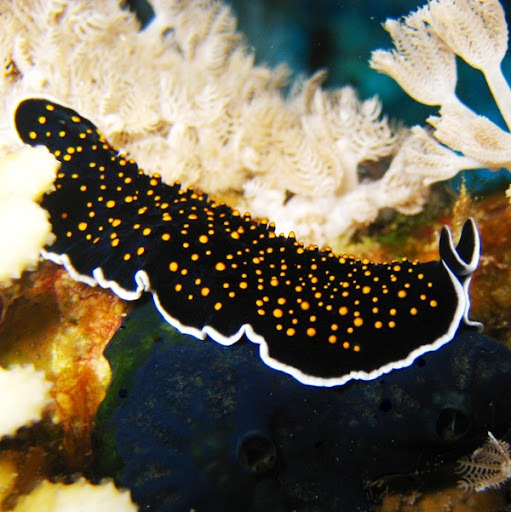




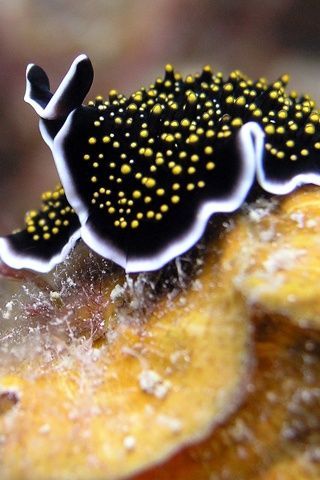

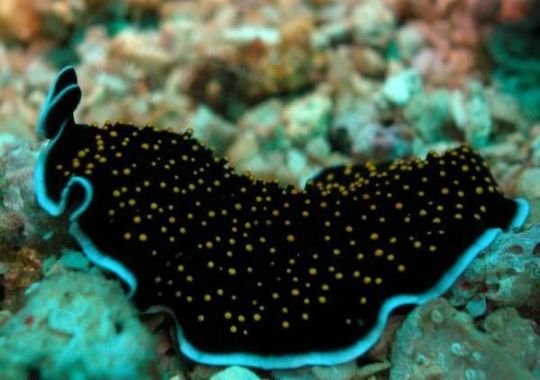
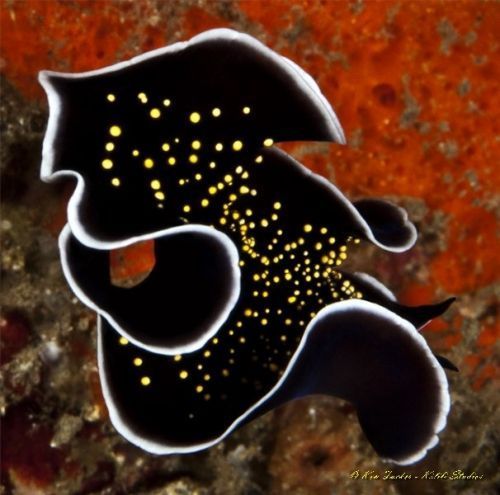

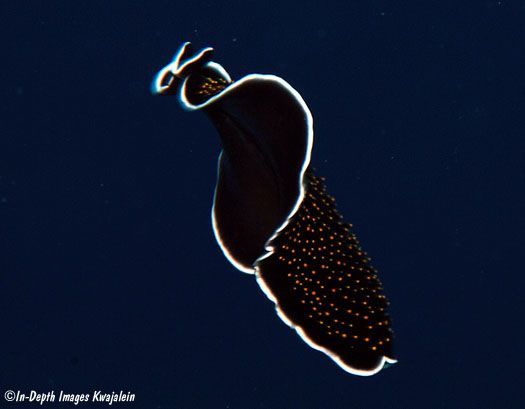

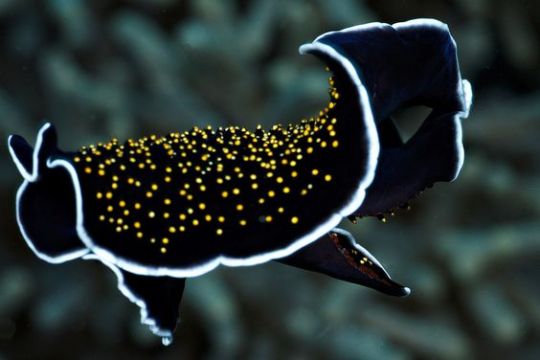
Червь плоский желтопятнистый (Thysanozoon havomaculatum) . Морской червь из класса ресничные черви, или турбеллярий. Принадлежит отряду Поликлад. Имеет уплощённое, овальное тело, покрытое ресничным эпителием. Длина этого симпатичного создания около 4 см, а толщина всего пару миллиметров. Передний конец его тела несёт пару щупалец. Мускулатура этого плоского червя многослойная, хорошо развитая, благодаря ей он способен подниматься в толщу воды за счёт ундулирующих движений краёв тела, а не только обитать на дне. Этот свободноживущий плоский червь питается преимущественно как хищник, водными беспозвоночными. Встречается в морях вокруг Австралии и Индонезии.
Yellow-spotted flatworm (Thysanozoon havomaculatum). A marine worm from the class of ciliated worms, or turbellarians. Belongs to the Polyclad squad. It has a flattened, oval body covered with ciliated epithelium. The length of this cute creature is about 4 cm, and the thickness is only a couple of millimeters. The front end of its body bears a pair of tentacles. The musculature of this flatworm is multi-layered, well developed, thanks to it it is able to rise into the water column due to undulating movements of the edges of the body, and not just live on the bottom. This free-living flatworm feeds primarily as a predator on aquatic invertebrates. It is found in the seas around Australia and Indonesia.
Источник:https://t.me/+t0G9OYaBjn9kNTBi, //www.webdive.ru/fotocat.php?t=11&id=20542&mode=view, http://mylongdongbay.blogspot.com/2007/07/save-ocean-cherish-marine-lives.html, /ru.pinterest.com/pin/630644754053053958/, http://www.akkiira.com/hiramushi/yoimiyaminohiramusi-swimming.html, //foxford.ru/wiki/biologiya/tip-ploskie-chervi?utm_referrer=https%3A%2F%2Fwww.google.com%2F.
#fauna#video#animal video#marine life#marine biology#nature#aquatic animals#Polyclad#Yellow-spotted flatworm#ocean#sea#corals#plankton#animal photography#nature aesthetic#видео#фауна#природа#Поликлады#Червь плоский желтопятнистый#океан#кораллы#планктон#море
824 notes
·
View notes
Text
HAPPY FLATWORM FRIDAY!!!! In honor of the accidental flatworm in my Sea Slug Sunday post I’m making an entire post dedicated to that species, the yellow spotted flatworm!!!
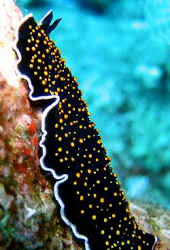




Happy flatworm Friday :)
Photos do not belong to me, I just got them off of Google
6 notes
·
View notes
Text
Weird ways of reproduction across the animal kingdom
Since a lot of people who don't understand sarcasm are mad at me because of that one post about bugs, I figured I should write something cool to soothe the biology side of tumblr.
Plus, I'm bored as hell and have plenty of time.
Anglerfish
Remember that one weird fish thing that showed up halfway through the first Nemo movie? The one with a lamp on its head and stuff?

This one???
In case you don't know, that's an anglerfish. They're probably one of the most famous "weird" fishes out there, with their bizarre-looking faces, tusklike teeth, and the lantern thing on their heads - which they use to hunt prey in the cold darkness of the deep seas.
But what if I told you this only applies to girls?
To begin with, male anglerfish don't have lamp things. Or tusks. Or anything resembling their female counterparts, really.

They are tiny, barely-functioning creatures who are easy prey to anything larger than a hand. The only way they survive for more than a week on the open darkness is due to their heightened sense of smell, which helps them to find food and mates.
And when the latter happens, things start to get crazy.
Anglerfish mate for life, because their life basically ends after they mate.
When a male anglerfish finds a partner, he'll start biting her skin on a random spot - usually on her back, as if trying to eat her. Then, amidst the constant lovebites, his whole body will start melting like an icecream cone under the summer. He won't mind, though, and will keep biting his girlfriend until he is completely fused to her skin and becomes a brand new organ on her body, being kept alive solely via the blood coming through her vascular system, which are now connected to his. The female can then use his sperm cells to impregnate herself whenever she feels like it.
One last thing before we go: this can happen to the same girl angler multiple times. Meaning that, somewhere under the sea, there's an angler with an entire harem's worth of males fused to her back. Cool.
Side-Blotched Lizard

The side-blotched lizard society is home to four different genders: male, female, gigachad and femboy.
For starters, we have the orange-throated lizard (left); which is usually stronger than the others and constantly adds new females to his territory, building a harem of his own. Though he is somewhat violent towards the other males and does protect the females from outside threats (and competitors), he does not form any sort of bond with them.
The blue-throated lizard (centre) is smaller, weaker, and only mates with a single female, which bonds with him for the rest of his life. Though he is weaker than the orange one, he does his best to protect his wife and maintains a (albeit smaller) territory of his own.
And then we have the yellow-throated lizard (right), which is my favourite one. They are weaker than the other two, have no territory of their own, and resemble females due to their colouration. He lives near the orange lizard's territory, and constantly sneaks in to mate with his wives when he isn't looking. Since the orange lizard doesn't form lasting bonds with his wives, he is not always near them, and they in turn have no problem mating with another male - the blue lizard's wive, however, will refuse any yellow lizards, remaning faithful to her husband instead.
Every article I found about these little guys says they're like a game of rock-paper-scissors - but for me, the way these guys mate is more similar to modern human relationship dynamics than any other primate I can think of.
Flatworm
These bitches look so cool. They're like the drag queen version of slugs.

To begin with, flatworms are all hermaphrodites. They can self-fertilise themselves in order to produce offspring, but they would rather not to. They are fully aware of Bateman's principle (Which has NOTHING TO DO with this Bateman, thank you very much), And hate getting pregnant, for it means spending valuable resources to nurture your offspring for a rather long period of time.
So, instead of self-fertilising, some species literally beat the shit out of their potential partner to decide which of them will get pregnant.
But since they have no hands, they use their penises instead.
A flatworm's dong is pointed - sometimes hooked - and capable of direcly injecting sperm on their partner (or adversary?)'s skin like a syringe, instantly impregnating them. The "match" usually lasts a couple of minutes, with the winner impregnating the loser and leaving to search for another adversary, and the loser eventually giving birth (metaphorically - they are egg-laying animals) to a new generation.
Neotrogla Wasp
I stand by my previous point - wasps are evil. But this one is kinda cool.

These wasps - which, unfortunately, are native to my home state and this is something I have to deal with - have an unique method of reproduction which some people call "gender-bender sex": the females have penises, which they inject into the males in order to suck sperm out of them. Here, the Bateman's principle is reversed: females try to mate with as many males as they can, whilst the males are more selective with their partners. The whole reproduction process can take over seventy hours to complete, and the happy couple will not be separated until it's over - when scientists tried to forcefully separate them, the male was split into two, its reproductive half remaining attached to his wife's lovemaking stick.
Jellyfish
Jellyfish are the coolest animals on the entire planet and none of you will ever make me change my mind.
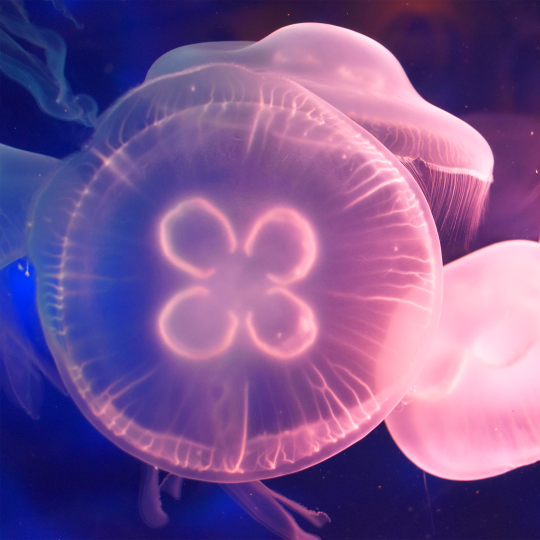
Jellyfish have this rather bizarre way of having babies, which combines asexual and sexual reproduction. Firstly, a jellyfish gives birth (again metaphorically - they have no coochies) to a larvae, which slowly grows into a polyp. After a certain point, the polyps stop eating and attach themselves to the seafloor, growing into something that resembles a mixture of a sack of coins and a sea anemone. After that, it becomes a strobila; whose top segments are slowly peeled off and drift away to become free-floating creatures known as ephyras, which then grow into an adult jellyfish.
Using human terms for familiarisation, it's kinda like if a woman gave birth to a walking womb, which then attached itself to a wall and slowly grew into a small pile of babies - which, in turn, slowly freed themselves from the pile; growing into a child, then a functional adult, to restart the cycle again.
Sharks
I don't particularly like sharks. They're like the dinosaurs of the oceans - people think they're so cool because they are big predators with sharp teeth, even though the actually awesome creatures are crawling through the unseen dephts, like a jellyfish. Still, their reproductive process is metal as hell.

To begin with, not all sharks lay eggs. Some of them get pregnant just like humans - though they obviously have no boobs to produce milk. One key difference is that a shark fetus will grow teeth whilst still in the womb, and if they do happen to share said womb with a sibling or two, it's not an uncommon occurence for them to literally bite themselves to death inside their mother. When this happens, one of the sharks usually keeps fighting until he's the only one in the womb, and he safely comes into this world knowing he'll always be his mum's favourite. (just kidding - sharks don't raise their young.)
This might be a bit "normal" compared to the other creatures on this list, but imagine if you're expecting triplets, only to give birth to a really buff baby with lots of scars nine months later. Like I said, metal as hell.
There was one other animal I was going to write about, but I forgot which one it was. So, uh, that's the end of the post. Make sure to subscribe and press the bell button. Or something like that.
#memes#fyp#fypツ#funny#explore#explorepage#hilarious#writers on tumblr#female artists#artists on tumblr#tumblr fyp#fypage#fypシ#foryou#viral#foryoupage#biology#entomology#wasps#jellyfish#anglerfish#fuck wasps#i hate wasps#insects#deep sea#sea life#sea creatures#marine life#marine biology#marine animals
30 notes
·
View notes
Text
Happy Nudibranch Nursday Flatworm Friday!!
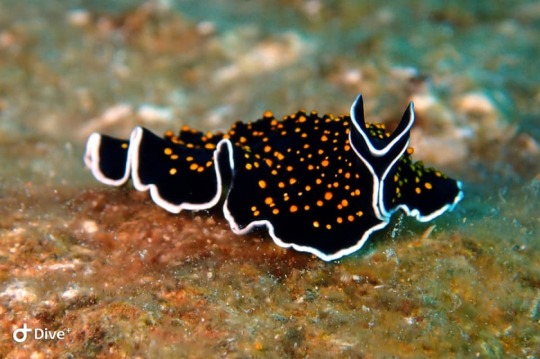

Today's Nudibranch FLATWORM is the Yellow-Spotted Flatworm! I adore these guys, they look like a goth doily covered in pollen or the orange blob stuff from Hollow Knight.
~~~
SURPRISE FLATWORM POST!! I made this post yesterday before realizing that flatworms aren’t Nudibranchs but I didn’t wanna discard the post, so here’s a surprise extra flatworm Friday post!
#cute#marine biology#biology#science#sea critters#i love little guys#informative#flatworms#surprise post#get pranked haha
8 notes
·
View notes
Text

100 Days of Sea Creatures Day 64 - Yellow Spotted Flatworm (Thysanozoon nigropapillosum)
#artists on tumblr#artists on instagram#drawing challenge#sea creature art#drawing daily#sea creatures#deep sea creatures#flat worms#platyhelminthes#marine invertebrates
8 notes
·
View notes
Text
Yellow-Spotted Flatworm (Thysanozoon nigropapillosum)
This is a Yellow-Spotted #Flatworm (Thysanozoon nigropapillosum). It is a #species of polyclad flatworms belonging to the family Pseudocerotidae. We spotted this lovely creature while diving off the coast of Fiji.
#underwater #wildlife #nature #sealife
This is a Yellow-Spotted Flatworm (Thysanozoon nigropapillosum). It is a species of polyclad flatworms belonging to the family Pseudocerotidae. We spotted this lovely creature while diving off the coast of Fiji.
Our dive guide referred to this enchanting invertebrate as a Yellow-Spotted Flatworm. However, it is also referred to as Gold-Speckled Flatworm, Yellow Papillae Flatworm, Yellow-Spotted…

View On WordPress
#ecotourism#Flatworm#marine biology#Nature#Scuba Diving#sea creatures#sea life#Underwater Video#wildlife
44 notes
·
View notes
Text
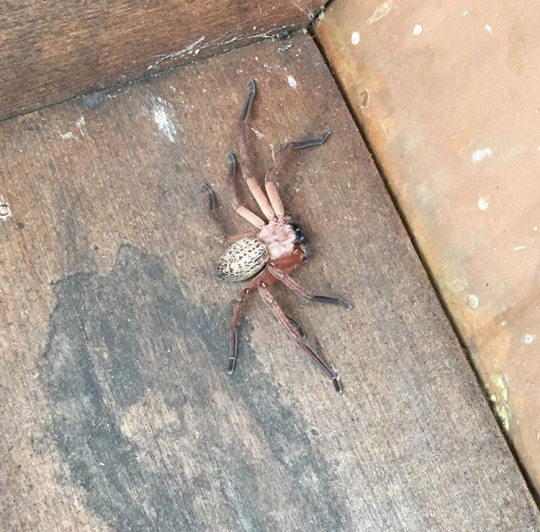

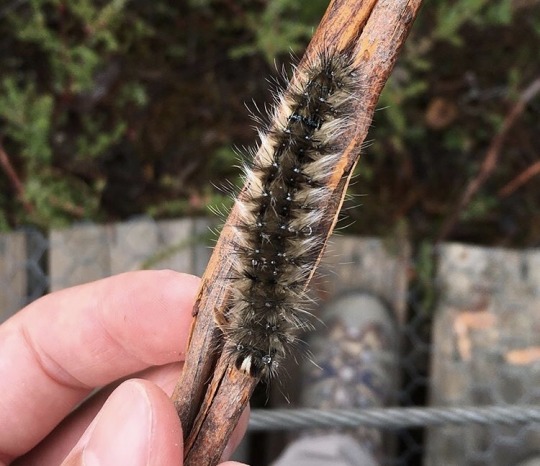
Variety of bugs I found at or nearby Cradle Mountain in Tasmania, Australia.
The yellow leech (I assume) was real cool to see. Longest leech I’ve ever seen and I’ve never seen one with that colouring before. Love that almost hot pink coloring at its head.
I assume the spider is a varient of a Huntsman. Found it in an old supplies box not too far from the Cradle Mountain Lodge. Never seen one with that pattern before.
The caterpillar was found if I recall right along the Waldheim Chalet hike route (again at a Cradle Mountain) no idea what sort it is but it’s clearly got a spot on hair grooming routine.
Very nice bug finds! The yellow dude is actually a canary worm which is a type of flatworm. The spider is definitely a huntsman, maybe a social huntsman, Delena cancerides. They can have that spotty butt. Excellent hairdo on the caterpillar! Looks like something in Anthelidae. Cute dudes! Thank you for sharing them :)
#bugs#animals#spider#insects#arachnids#submission#flatworm#canary worm#worm#huntsman spider#social huntsman#caterpillar
75 notes
·
View notes
Text
ACNL icons - fish
originally ripped by redblueyellow
cropped and saved as individual images for embedding purposes - useful for blog buttons, favicons, custom mouses, etc.
full list under the readmore, listed alphabetically for easy searching
fresh water

angel fish

arapaima

arowana

barbel steel

bitterling

black bass

bluegill

carp

catfish

char

cherry salmon

crawfish

crucian carp

dab

dace

dorado

eel

freshwater goby

frog

gar

giant snakehead

goldfish

guppy

killifish

king salmon

koi

loach

mitten crab

neon tetra

nibble fish

pale chub

pike

piranha

pond smelt

pop-eyed goldfish

rainbow trout

saddled bichir

salmon

soft-shelled turtle

stringfish

sweetfish

tadpole

yellow perch
salt water

barred knifejaw

blowfish

blue marlin

butterfly fish

clown fish

coelacanth

football fish

giant trevally

hammerhead shark

horse mackerel

moray eel

napoleonfish

oarfish

ocean sunfish

olive flounder

puffer fish

ray

red snapper

ribbon eel

saw shark

sea bass

sea butterfly

seahorse

shark

squid

surgeonfish

tuna

whale shark

zebra turkeyfish
sea floor

abalone

acorn barnacle

chambered nautilus

clam

ear shell

flatworm

giant isopod

horsehair crab

horseshoe crab

lobster

mantis shrimp

octopus

oyster

pearl oyster

red king crab

scallop

sea anamenone

sea cumcumber

sea grapes

sea slug

sea star

sea urchin

seaweed

snow crab

spider crab

spiny lobster

spotted garden eel

sweet shrimp

tiger prawn

turban shell
98 notes
·
View notes
Text
Last year, I wrote a post on some wasps and bees I’ve found in my garden over the nine years I’d lived here. This is the second installment of the Garden Insects series, on butterflies & moths and their larvae. Future posts will cover flies, dragonflies, ants, beetles, grasshoppers, cicadas, and other bugs — some “true” bugs and some not. Possibly even worms and slugs, though they are not insects, or even in the same phylum as insects. Speaking of phylum …
_________________
SIDEBAR: The taxonomy of the insect world, briefly.
Insects are a CLASS in terms of taxonomy, within the PHYLUM called Arthropoda that’s part of the overarching KINGDOM Animalia, which contains about 2.2 million animal species, So yes, all insects are animals, though people often dispute this in casual conversation and social media.
Depending on how a phylum is determined (including whether only extant (non-extinct) animals are included or not), there are anywhere from 5 to 36 phyla in the animal kingdom; usually lists show 7 or 9 phyla, such as this one from a Yale University course that lists 9 phyla, the first 6 of which contain animals that live only in water or mud: Porifera (Sponges), Cnidaria (Jellyfish, Coral, Sea Anemones), Mollusca (Snails, Slugs, Octopus), Echinodermata (Starfish, Sand Dollar, Sea Cucumber, Sea Urchin), Annelida (Segment Worms, Leeches), Platyhelminthes (Flatworms), Nematoda (Nematodes, Roundworms, Earthworms), Chordata (everything with a backbone, so all Birds, Reptiles, Fishes, Amphibians and Mammals, including humans), and finally, Arthropoda (Insects, Spiders, Scorpions, Millipedes, Crustaceans).
This sortable list on Wikipedia, similar to a BBC Earth list, contains 35 phyla, but often many of these are considered a sub-phylum of a more encompassing phylum. Here’s a site that lists 21 phyla, while the Tree of Life project lists just 6: Porifera and Cnidaria, as above in the list of nine, but then none of the other seven, instead adding to and replacing them with Placozoa (extremely simple animals up to 3mm in size made up of only 4 cell types; only 2 species have ever been described), Ctenophora (comb-jellies), Myxoza (several-celled parasitic microscopic organisms) and the giant group of Bilateria, which includes all the vertebrates plus arthropods, molluscs, worms, and more!
Categorising life is complicated.
And don’t get me started on the top level of life Kingdoms (or Domains or Empires):
“In summary, today there are several competing top classifications of life:
The three-domain system of Carl Woese, with top-level groupings of Archaea, Eubacteria, and Eukaryota domains
The two-empire system, with top-level groupings of Prokaryota (or Monera) and Eukaryota empires
The five-kingdom system with top-level groupings of Monera, Protista, Fungi, Plantae, and Animalia
The six-kingdom system with top-level groupings of Archaebacteria, Monera, Protista, Fungi, Plantae, and Animalia
Overall, the majority of biologists accept the domain system, but a large minority uses the five-kingdom method.” (from New World Encyclopedia: Taxonomy)
So, leaving the weeds to recap for today’s posting on insects, insects comprise one CLASS (called Insecta) of the PHYLUM Arthropoda, which also contains, in other classes (not Insecta) such animals as arachnids (spiders, scorpions, ticks, mites, et al.), crustaceans, millipedes and centipedes, horseshoe crabs, and so on.
Within the CLASS Insecta are about 30 ORDERS, including our focus today, Lepidoptera (butterflies and moths), plus:
Hymenoptera: ants, bees, wasps, sawflies … it’s a big group
Hemiptera: all true bugs, within three sub-orders: Heteroptera – bugs; Auchenorrhyncha – cicadas, leafhoppers; and Sternorrhyncha – aphids, scales. True bugs are insects that have two pairs of wings and hypodermic-needle-like mouthparts, and they all undergo incomplete metamorphosis, with their young hatching from eggs to become nymphs, which are miniature versions of the adult bug minus the wings.
Diptera: flies — but not all insects with the word “fly” in their names; also mosquitoes
Coleoptera: beetles
Orthoptera: katydids, grasshoppers, crickets
Odonata: dragonflies & damselflies, each in its own sub-order
Trichoptera: caddisflies
Ephemeroptera “lasting a day”: mayflies
Mantodea “like a prophet”: mantises
Phasmatodea “like a ghost”: walking sticks
… and a couple dozen more. (Check out Bugguide’s intro or the list here.)
_________________ END OF SIDEBAR
*
Now on to the butterflies and moths, and their larva, i.e., caterpillars. (All photos from my yard this year unless noted otherwise.)
What’s interesting to me is that I commonly see both the larval and adult forms of some butterfly species, such as monarch butterflies and caterpillars (Danaus plexippus), while I typically see only either the larval or the adult form of others, such as black swallowtail butterflies (Papilio polyxenes); I’ve seen a handful of black swallowtail caterpillars in my yard this year and no adults, though I’ve seen a few flying around town. Same thing with yellow swallowtail butterflies, either Eastern tiger, Papilio glaucus or Canadian tiger, Papilio canadensis — I’m never sure which; I see lots of adults and no caterpillars, which are darned cute.
(Male) monarch butterfly, 12 Aug 2019; monarch caterpillar, 25 July 2019:
I like this monarch-in-flight photo that the motion camera caught on 2 Aug. 2019.

I’ve had two chrysalises hatch successful adult monarch butterflies in the garden, and I’ve seen at least three dozen monarch caterpillars on the milkweed plants (Asclepias syriaca and A. incarnata) since mid-July, including one large one today, which is getting to be too late for pupating, hatching, and flying to Mexico.
*
Black swallowtail butterfly, in the garden in Sept. 2015 ; black swallowtail caterpillar, 17 Sept 2019:
I’m still seeing black swallowtail caterpillars on dill in the garden now, too.
*
These are both Eastern yellow tiger swallowtails, both photographed on 25 July 2019; the one on the left is a female (more blue), the one on the right a male. I don’t have any photos of yellow tiger caterpillars, never having noticed one, but here’s one online — cute, right? Kind of like a spicebush caterpillar.
*
Similarly with MOTHS: I’ve seen loads of tussock moth caterpillars this year — it’s been a banner year for them in the northeast — but no adult tussock moths (they are beige and somewhat nondescript):

spotted tussock moth caterpillar (Lophocampa maculata) foreground, and looks like a banded tussock moth caterpillar (Halysidota tessellaris) in the background – 11 Sept 2019
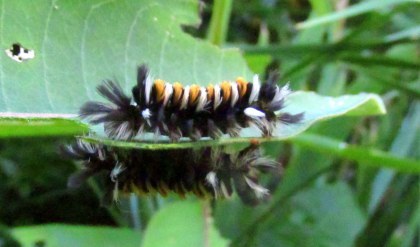
milkweed tussock moth caterpillar (Euchaetes egle), on milkweed – 25 Aug 2019

banded tussock moth caterpillar (Halysidota tessellaris) – 13 Aug 2019
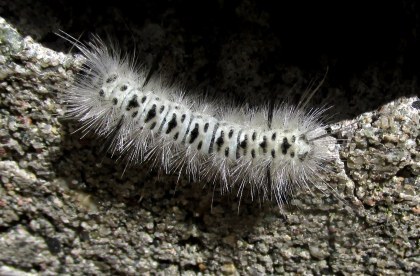
hickory tussock moth caterpillar (Lophocampa caryae) – 11 Aug 2019
*
I’m likewise seeing a fair number of woolybears, those fuzzy caterpillars of the banded woolybear moth aka Isabella tiger moth, Pyrrharctia isabella or of the yellow woolybear moth, aka Virginian tiger moth, Spilosoma virginica, but I’ve not noticed any actual moths of the species:

I think this is a Yellow Woolybear Moth caterpillar aka Virginian Tiger Moth (Spilosoma virginica), on the garden hose, 12 Aug 2019

And this is another Virginian Tiger Moth (Spilosoma virginica), seen not in my garden but at Laudholm Farm in Wells, Maine on 9 Sept. Quite different in appearance.

Here’s a banded woolybear moth caterpillar aka Isabella tiger caterpillar (Pyrrharctia isabella), taken nearby my home in New Hampshire last year, Oct. 2018; I’ve seen some this year but haven’t been able to get photos.
Obviously, I’m probably just not noticing or recognising the moths in their adult forms (they tend to blend), and I’m not out at night prowling around or leaving lights on to lure them, but the swallowtail situation is more perplexing to me, as they are fairly striking in both forms.
*
A new one for me this year has been the American dagger moth caterpillar (Acronicta americana). I first saw it coiled in a round disk on the patio (27 July) and wasn’t sure it was even an animal.

But folks on Facebook insect pages assured me it was. I’ve since seen the same species in other spots in the yard. Here’s a bedraggled one on a peach, 3 Sept.:

Here’s another, all curled up in a small Japanese maple (‘Bloodgood’) tree a few days ago.

There’ve been other dagger moth caterpillars around as well, including these larvae of the splendid dagger moth (Acronicta superans), both seen on 19 Aug. 2019 but at least 15 yards from each other, the first on a purple leaf sand cherry (Prunus × cistena) and the second on the shed.


I saw this one on a sidewalk in town on 16 Aug. 2019; it’s a fingered dagger moth caterpillar.

fingered dagger moth (Acronicta dactylina) caterpillar, 16 Aug. 2019
And this one also in town, on 13 Sept. 2019, a yellow-haired dagger moth (Acronicta impleta) caterpillar:
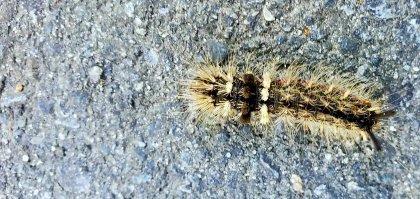
*
A couple more moth larva seen locally this summer:

rosy maple moth (Dryocampa rubicunda) caterpillar, 22 Aug. 2019, on a local trail

a polyphemus moth (Antheraea polyphemus) caterpillar ready to pupate (this is why it’s orange and not green), 26 Aug 2019, on a local sidewalk and heading toward the road (I moved it)
*
The clymene moth (Haploa clymene), a kind of tiger moth, is a very distinguishable species that I seem to see about once a summer on the lawn. This photo was taken on 30 July 2019. I’ve never noticed it in its larval form, which somewhat resembles a webworm.

*
This ipsilon dart moth was a new one for me, and I might not have noticed it on the ground if it hadn’t moved a bit. I posted it two two Facebook insect ID groups and I’m amazed that with the sunlight glaring on this specimen, two people in two separate groups actually recognised it!

Agrotis ipsilon (Ipsilon dart) moth, 8 Sept 2019
*
Another new one for me is this tiny boldly marked Archips moth (Archips dissitana), seen on Clintonia borealis (blue-bead lily) alongside a local trail, 28 July 2019; sorry it’s a bit blurry:
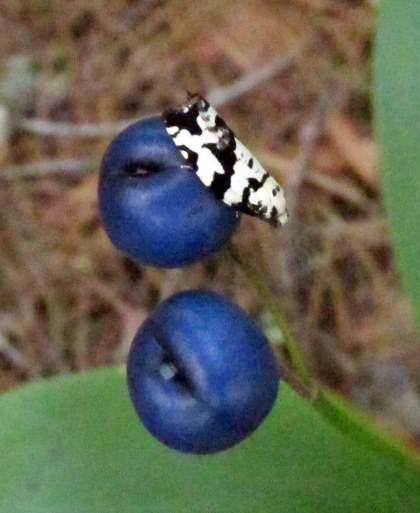
boldy marked Archips moth (Archips dissitana) on Clintonia bead, Sutton, NH, 28 July 2019
*
This giant luna moth (Actias luna) was a new and serendipitous sighting for me as well!

luna moth (Actias luna) on a local bakery storefront, 30 June 2019
*
Two moths that look more like tiny hummingbirds are the clearwing moths: the hummingbird clearwing (Hemaris thysbe) that’s olive and reddish-brown, and the snowberry clearwing (Hemaris diffinis), which is black and yellow. We’ve had many of both here all summer.
This is the hummingbird clearwing (Hemaris thysbe), on bee balm (monarda) and buddleia ‘Ellen’s Blue’:
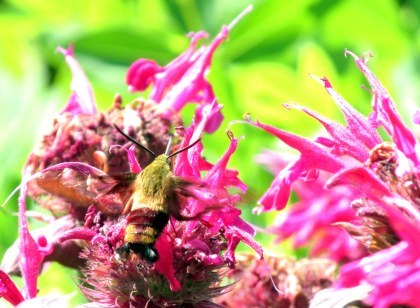

And this is the snowberry clearwing (Hemaris diffinis), on buddleia ‘Ellen’s Blue’:


I love the curled proboscis in the second photo.
*
BACK TO BUTTERFLIES
Besides the monarch and yellow swallowtails, above, another butterfly showing up here in droves this season is the painted lady (Vanessa cardui). I can’t decide if it’s more beautiful from the side or with wings open. (Shown here, on 10&11 Sept.) on buddleia, sedum, and Joe Pye weed.) There are still a lot of them around even now.
I guess I like the side the best!
Oddly, a naturalist writer near Keene, NH, about 50 miles southwest, said last week that he hasn’t seen any painted ladies this summer!
We’ve also had a fair number of American lady butterflies (Vanessa virginiensis) this season. They have only two big circles on the side of the wing, and the markings on their hindwings are quite different, too. (Shown here, from 24 July – 24 Aug,, on clethra ‘Ruby Spice’ and echinacea)
And look, I actually managed to find the larval form of the American lady!

*
I haven’t seen many white admiral butterflies (Limenitis arthemis) in the garden this year, but was able to photograph the tattered varmint on buddleia on one of the few days when I did (11 Sept. 2019). It’s a strange species, having two very different forms that used to (understandably) be considered two separate species; one is a red-spotted purple form, and the other is the “white” version, which is really black, white, blue, and reddish.

Last year I spotted one on a rotting peach (4 Sept 2018).
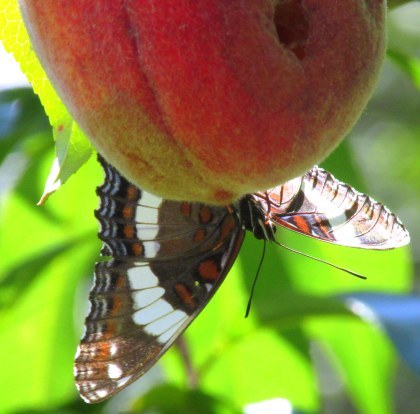
And here’s the red-spotted purple version on buddleia in the garden, seven years ago, on 1 Aug. 2012
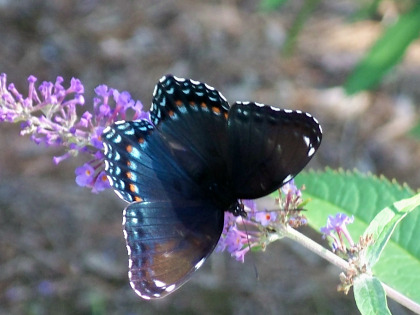
*
Early in the season we had some small fritillaries, which are so common in the south (Jekyll island, GA, for instance – especially gulf fritillaries) but not as much up here. This one was seen on 24 July 2019. I think it’s a great spangled fritillary (Speyeria cybele). We also have an aphrodite fritillary (Speyeria aphrodite) here, somewhat smaller but otherwise I can’t tell them apart.

*
These are all skippers, a small butterfly; I don’t know their species (there are almost 40 species of skippers in New Hampshire). There were a bunch around the yard in July.

27 July 2019

11 Aug. 2019 on echinacea … maybe Peck’s skipper (Polites peckius)
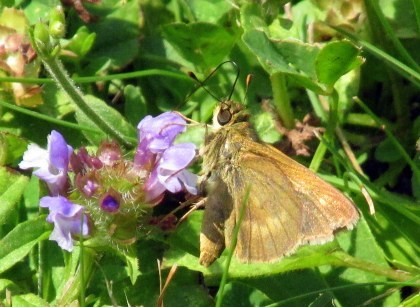
27 July 2019 on self-heal in the lawn
*
I saw a few duskywing butterflies (genus Erynnis, a kind of skipper) in July and August, including this one (I think):

duskywing butterfly (Erynnis spp) on echinacea, 3 Aug. 2019
There are 12 or so species of duskywing, sootywing, and cloudywing butterflies in New Hampshire and they all look kind of alike.
*
Here are a few more butterflies I’ve seen this year in places that aren’t my garden.
This one wasn’t even in New Hampshire, but I rarely see an Eastern comma (Polygona comma) butterfly:

Eastern comma butterfly (Polygonia comma), Laudholm Farms in Wells, Maine, 9 Sept. 2019
A couple of sightings of the common buckeye butterfly (Junonia coenia).
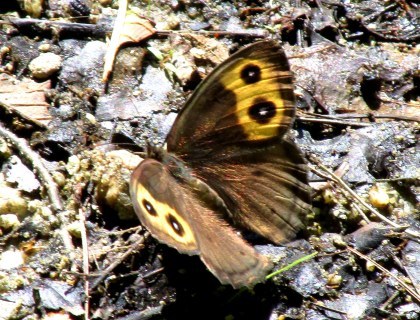
New London, NH, 26 Aug. 2019
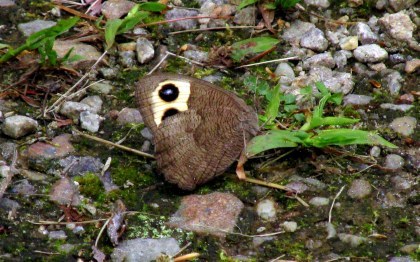
Great Bay NWR, Newington, NH, 23 Aug. 2019
*
A northern spring azure (Celastrina lucia) — I see many azures (both spring and summer species) but they are very small and very fast, hard to capture on film.
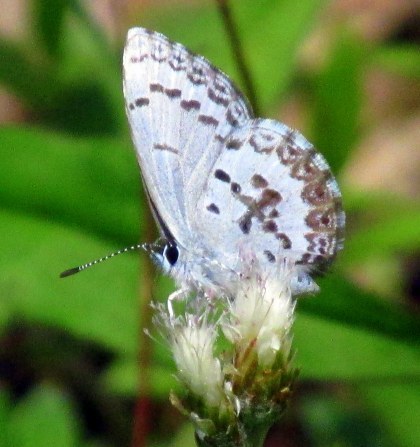
northern spring azure butterfly (Celastrina lucia), 25 May 2019
*
A crescent butterfly, probably a northern crescent (Phyciodes cocyta), but possibly a pearl crescent (Phyciodes tharos).

crescent butterfly, Enfield, NH, 19 June 2019. There are three kinds in NH — tawny, northern, and pearl; I think this is the northern crescent (Phyciodes cocyta).
*
A clouded sulphur (Colias philodice) butterfly, at The Fells Estate in Newbury, NH, 22 Sept. 2019, on pink asters:

*
This eyed brown (Satyrodes eurydice) butterfly was a new one for me. The common names — eyed brown and marsh eyed brown — just sounds incomplete to me. There’s also a Satyrodes appalachia, Appalachian brown or woods eyed brown, which is very similar (they were previously thought to be the same species), and it’s possible that’s what this is, but people who know more than I do about these things identified it as S. eurydice.
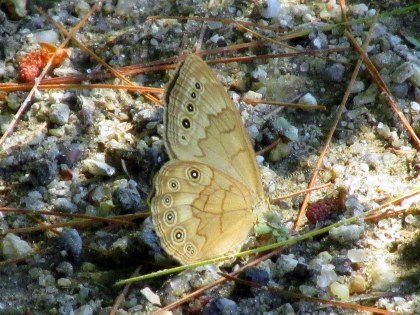
Satyrodes eurydice (Eyed Brown/Marsh Eyed Brown butterfly), Sutton, NH, 5 July 2019
*
Finally, these butterflies are fairly common here but I haven’t taken any photos of them (or even noticed a copper) yet this year, so I’m including garden photos from previous years.

cabbage white (Pieris rapae) butterfly on ‘Bluebird’ Aster laevis, 27 Sept. 2018.
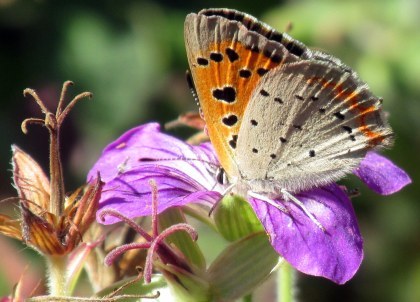
American copper (Lycaena phlaeas) butterfly on geranium, 18 Sept. 2015
I’ve never seen a mourning cloak (Nymphalis antiopa) in my garden but I see them along some trails in early spring; their our earliest butterflies. I actually saw one this spring but couldn’t get a good shot of it, so here’s a mourning cloak along a trail in Concord, NH, 23 April 2016.
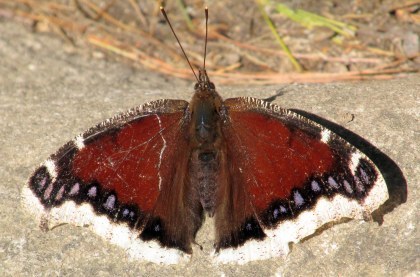
*
Sources:
The Animal Kingdom, by Joe Lewis, Yale-New Haven Teachers Institute
Ask a Biologist: True Bugs, by Adam Dolezal and Page Baluch
Phylogenic List of Insect Orders
Hummingird Moth (Mass Audubon)
Side-by-Side American Lady and Painted Lady butterflies (Mass. Butterfly Club)
Wildlife Journal Junior – NH PBS – list of insects (mostly butterflies) in NH
Featured image: monarch butterfly drying wings after eclosing, 11 Sept. 2019.
Garden Insects: Butterflies, Moths, and Caterpillars (Lepidoptera) Last year, I wrote a post on some wasps and bees I've found in my garden over the nine years I'd lived here.
#American lady#butterflies#caterpillars#clearwing moths#dagger moth#fritillary#insects#larva#lepidoptera#monarch#moths#painted lady#skipper#swallowtail#taxonomy#tiger moth#tussock moths
0 notes
Photo

Original content owned & copyrighted by Green Global Travel.
Lanky, awkward, affectionate, and endearing… you’d be hard pressed to find someone who’s not intrigued by Giraffes. These evolutionary marvels, which get their name from the Arabic word Zarafa (“one who walks swiftly”), are statuesque wonders of elegant beauty.
Native to their numbers are declining fast due to poaching and habitat loss, with the Giraffe population in Africa dropping by 40%. They’re also preyed upon by added to the IUCN’s Endangered Species List, with several subspecies currently listed as critically endangered. So here’s a look at 50 fascinating facts about Giraffes, including the most common subspecies, their diets, and what’s being done to save them.
READ MORE: Animals in Kenya (A Guide to 40 Species)
Basic Giraffe Facts
Giraffe Neck & Body Facts
Giraffe Mating & Gestation
Giraffe Diet
Masai Giraffe
Reticulated Giraffe
Rothschild’s Giraffe
Why are Giraffes Endangered?
Giraffe Conservation
Fun Giraffe Facts
Giraffe in Nairobi National Park, Kenya
FACTS
1. Though once believed to be a single species, four distinct Giraffe species are now recognized: the Southern Giraffe, Masai Giraffe, Reticulated Giraffe, and Northern Giraffe. They’re classified based on their color, patterns, and geographical regions they inhabit. There are also several subspecies, including the Angolan Giraffe, Nubian Giraffe, West African Giraffe, Rothschild Giraffe, and Kordofan Giraffe.
2. The earliest known giraffid, the Palaeotragus, lived approximately 20 million years ago. This prehistoric species was tall, but did not have as long a neck as Giraffes do now. Living in areas of barren soil led them to reach for leaves in the trees. After countless generations of stretching, they evolved genetically into the Giraffe we know today.
3. Female Giraffes are known as cows, while males are called bulls and baby Giraffes are calves. They’re classified as a species of the Artiodactyla order, along with about 220 other mammals. These (including Cows, Deer, Okapi. The black and white, Zebra-like legs of the Okapi can be deceiving. But a closer look at its head shows a striking resemblance to the Giraffe’s long ears and face.
5. Giraffes live together in herds with an average of 10 to 15 individuals. This helps them survive against predators, taking turns feeding while others look out for danger. Though they’re generally mild-mannered, an adult Giraffe can shatter a Lion’s skull with one powerful kick.
6. Hungry carnivores are not the only threatening creatures the Giraffe has to fear. In fact, the most dangerous ones are no larger than a seed. Tiny ticks feast on the Giraffe’s blood, leaving them weak and tired. Nematodes and flatworms can also be ingested through water, causing infections and skin disorders. Tanzania’s Ruaha National Park has observed 79% of its Giraffe population showing signs of infection.
7. Surviving in the harsh African READ MORE: Top 10 National Parks in Tanzania
Giraffe in Tarangire National Park, Tanzania
NECK & BODY FACTS
8. The neck is obviously the species’ most distinctive physical trait, measuring up to six feet long and weighing around 600 pounds. The length of the Giraffe neck gives the illusion of a complex anatomical structure underneath. But these towering creatures have only seven neck vertebrae (just like humans!), each of which is about 10 inches long and connected with ball-and-socket joints for flexibility.
9. The Giraffe’s neck length requires huge, hot air balloon-like lungs, which are eight times the size of a human’s. However, they breathe at a much slower rate because of the “dead air” that gets caught in their long tracheas. So previous breaths are not fully released before the animal begins inhaling again.
10. The Giraffe is the tallest living mammal on Earth. Males grow to be about 18 feet tall. Females are slightly shorter than the males, but still reach a staggering height of 14 feet.
11. Giraffes have humongous hearts that weigh around 25 pounds, generating enough pressue to propel blood up through their long necks and into their brains. They also have special blood vessels that contain valves that help prevent the backtracking of blood from gravity.
12. The two horns that stick out of the Giraffe head are not real horns, but ossicones– a form of thick cartilage covered in skin. Baby Giraffes are born with flat ossicones to avoid injury during birth, but they grow as they mature into adults. Males have thicker ossicones, which they use in mating-related battles.
13. Giraffes are fairly quiet beings: They do have a larynx (a.k.a. voice box), but rarely use it. If they become alarmed, a simple snort is often used to alert the herd of a possible threat. They’re also known to produce a mild humming sound during the night, perhaps to help locate other herd members in the dark.
14. Everything about the Giraffe is long, including its luscious eyelashes. This helps to keep dust out of their big eyes, which are the size of golf balls. They sit laterally on the Giraffe’s head, providing them with keen eyesight. They can’t see in full color, but they do see shades of red, orange, yellow-green, and violet.
15. Animals with hoofed feet, such as the Giraffe, are known as ungulates. Each foot has two even hooves. Each of an adult Giraffe’s feet are about 12 inches wide. These large hooves give them stability and prevent them from sinking into loose sand.
16. Sometimes known “stink bulls,” Giraffes carry a not-so-pleasant odor. Their fur releases natural repellents like indole and 3-methylindole (the same compounds found in feces) to ward off insects and parasites. Researchers believe this pungent odor tells potential mates that they’re free of parasites.
17. Giraffes have also been spotted using their grapple-like tongue to pick their noses.
READ MORE: Exploring Magical Tarangire National Park, Tanzania
Reticulated Giraffes in Meru National Park, Kenya
MATING & GESTATION
18. Male Giraffe necks are massive and powerful. To establish mating rights, bulls participate in a fighting ritual in which they swing their mighty necks like swords, delivering powerful blows by ramming their heads into each other’s bodies. Their heavy skulls are coated with calcium to shield their brains. Although it is very rare, there have been recorded deaths from these intense battles.
19. Female Giraffes mate with dominant males in hopes of passing on strong genes. They ovulate every two weeks, allowing for year-round Giraffe mating. Ovulating females release pheromones that attract males, who may sip her urine to confirm she’s ready to mate. The willing males will follow her to await her decision on who she wants to reproduce with.
20. Once successful Giraffe mating occurs, the the gestational period is approximately 15 months. The mother brings her a single baby into the world while standing up, causing the newborn to fall about six feet to the ground. The rough landing breaks the amniotic sac and umbilical cord, and encourages the baby Giraffe to start breathing.
21. Some Giraffes have been reported returning to the place where they were born to give birth.
22. Within an hour of birth, a baby Giraffe can get up and walk on its own. This is crucial so that it can quickly move with the herd in case a predator comes near. Even with its shaky, lanky legs, the newborn stands taller than most humans (about six feet) and weighs an average of 150 pounds.
23. Mothers are extremely protective of their young. They will form “nursery groups” with other females from the herd, taking turns watching over the extremely vulnerable baby Giraffes. Sadly, only about 20% of all Giraffes live to reach adulthood.
24. Although they’re not considered adults until age four, male calves will leave their mothers at around 15 months old and join all-male bachelor groups. They’ll contest for dominance while still coexisting peacefully. Once they’re ready for mating, dominant male Giraffes will visit a female herd.
READ MORE: Meru National Park, Kenya (From Joy Adamson to Elsa’s Kopje)
Masai Giraffe in Kruger National Park, South Africa
DIET
25. Baby Giraffes are very dependent on their mothers for the first 4 to 6 months, relying on their milk for nutrients. After that, the mother will pull leaves off trees to feed to them until they’re tall enough to reach their own. An adult Giraffe will typically consume about 66 pounds of food per day.
26. Giraffes possess an 18-inch prehensile tongue that can grip objects, much like a ruminants. Much like bovines (including Cows, Buffalo, and the READ MORE: How to Get the Most For Your Kruger National Park Entrance Fee
Masai Giraffe in Maasai Mara National Reserve, Kenya
30. Also known as the Kilimanjaro Giraffe, the Masai or
32. Although Tanzania has recently increased its declared endangered by the International Union for Conservation of Nature (IUCN).
READ MORE: Maasai Mara Conservancies (Community-Based Conservation in Kenya)
Reticulated Giraffes in Lewa Conservancy, Kenya
33. If you’ve been to any 34. The subspecies’ appearance is distinguished by their wide, reddish, polygonal spots, which are outlined with bright white lines.
35. Unfortunately, Reticulated Giraffe habitat is facing destruction, causing them to disappear in the wild. Their current population is around 15,780 (less than half what it was 30 years ago), causing them to be added to the IUCN Red List of endangered species in 2018.
36.) Two completely white Reticulated Giraffes were spotted at Kenya’s Ishaqbini Hirola Conservancy in 2017. The unusual mother-daughter duo have a genetic condition called leucism, which inhibits pigmentation in the skin cells. Only three of these incredibly rare white-skinned Giraffes have been reported in sightings by the READ MORE: Minnesota Zoo Conservation (How Zoos Help Endangered Species)
Rothschild’s Giraffe at Giraffe Centre in Nairobi, Kenya
ROTHSCHILD’S
37. The Rothschild’s Giraffe is named after famous British zoologist Walter Rothschild, who is best known for the collection now housed at the Natural History Museum at Tring.
38. The subspecies is also known as the Baringo Giraffe (after the Lake Baringo area of northern Kenya) or the Ugandan Giraffe. All remaining in the wild inhabit protected areas in these two regions. It was once believed that the Rothschild’s Giraffe and the Nubian Giraffe were completely different subspecies, but recent research has discovered that the two are genetically identical.
39. It’s easy to tell the Rothschild’s Giraffe from other subspecies. Their coat looks a bit like the Masai Giraffe, but with sandy skin and less jagged, caramel-colored patches that give them a more yellowish coloring. They also have no markings on the lower leg, and are the only Giraffes born with five ossicones, with smaller bumps in the center of its forehead and behind each ear.
40.) Rothschild’s Giraffe rank among the most endangered subspecies of Giraffes, with approximately 1,399 individuals remaining in the wild. Nairobi’s Giraffe Centre, run by the African Fund for Endangered Wildlife, is a great place to see these endangered beauties up close.
READ MORE: The Best Environmental Charities & Animal Charities to Donate To
Masai Giraffe in Serengeti National Park, Tanzania
ARE S ENDANGERED?
41. In what’s being called a “silent extinction,” Giraffe population numbers dropped from 155,000 in 1985 to 97,000 in 2015, according to the International Union for the Conservation of Nature. Habitat destruction is the leading reason Giraffes are endangered. Rapid expansion of human development and the effects of war continue to fracture the various subspecies’ home lands.
42. Like most high-profile species of sub-saharan wildlife, Giraffes are also increasingly threatened by READ MORE: 15 Harmful Traditions & Cultural Practices Tourists Shouldn’t Support
Giraffe in Wild Rivers Nature Reserve in South Africa’s Greater Kruger Area
CONSERVATION
44. As recently as 2010, Giraffes were considered “Least Concern” in terms of conservation consideration by the IUCN. But by 2016 the entire species has been classified as Vulnerable, and may no longer exist in their historic habitat in Angola, Eritrea, Guinea, Mali, Mauritania, Nigeria, and Senegal.
Fortunately, the UN-backed Convention of Migratory Species selected Giraffes for special protection in 2017. Today there are numerous sanctuaries and national parks all around the African continent that are striving to provide them with a safe haven.
Here’s a brief list of the major Giraffe conservation NGOs working to protect the beloved species for future generations:
• African Fund for Endangered Wildlife– The NGO behind Nairobi’s Giraffe Centre has a huge focus on educating kids from local communities about the importance of wildlife conservation. Their sanctuary is also a leading light in breeding endangered Rothschild’s Giraffes and releasing them into the wild.
• African Wildlife Foundation– The AWF works to educates local communities on sustainable agricultural practices in hopes of limiting human-animal conflict, as well as leading acacia planting projects in areas where Giraffe habitat has been deforested.
• Giraffe Conservation Alliance– This nonprofit organization works to connect people and zoos around the world to Giraffe conservation projects in Africa in hopes of ensuring a sustainable future for all Giraffe subspecies.
• The Giraffe Conservation Foundation– The GCF is the only NGO in the world that concentrates solely on the conservation and management of Giraffe in the wild throughout the African continent. They’re currently involved in conservation initiatives in 15 different countries.
• The Wildlife Conservation Society – The WCS monitors Giraffe populations to control habitat loss and poaching, as well as collaborating with other wildlife conservation groups on joint efforts.
READ MORE: Top 15 Female Wildlife Conservationists & Animal Rights Activists
Giraffe Rainbow in Nairobi National Park, Kenya
FACTS
45. Despite being herbivores, Giraffes oddly seem to enjoy chewing and sucking on bones (which is known as osteophag). They primarily pick on barren carcass remnants when their bodies are very low on nutrients. This supplies them with extra calcium and phosphorous in order to strengthen their bones, which is especially beneficial for males preparing for “necking” battles over mating rights.
46. Did you know that Giraffes are pollinators? They inadvertently collect pollen on their fur when rummaging through the trees. Much like bees
, they carry this pollen to other trees (especially acacias), allowing them to blossom. Other surprising pollinators include Bats, Rats, and even certain 50 Fascinating Facts About Giraffes appeared first on Green Global Travel.
#><strong>Africa</strong></span></a>#008000;#><strong>Leopards</strong></span></a>#giraffe#giraffefacts#giraffefactslife#giraffefactsworld#giraffefactsanimals#giraffefactspictures#africansafarianimals#africansafarianimalsgiraffes#africanwildlife#animals#animalfacts#animalfactsinteresting#animalfactswild#><strong>Goats</strong></span></a>#><strong>wilderness</strong></span></a>#><strong>Elephant’s</strong></span></a>#><strong>Saola</strong></span></a>)#><strong>Kenya</strong></span></a>#333333;#><strong>anti-poaching#>wildlife
0 notes
Video
Credit 📽 @appimaalimee YELLOW-SPOTTED FLATWORM 💙💙💙 °°°°°°°°°°°°°°°°°°°°°°°°°°°°°°°°°°°°°°°°°°°°°°°°°°°° It's so satisfying to see them swimming freely 😍😍😍 These colorful animals can be found moving swiftly across the reef, but to catch one in open water is the real treat. Flatworms are soft-bodied invertebrates which propel themselves through the water with a mesmerizing wave of the body. Have you ever seen a swimming flatworm? Tag someone who would love to swim with this cuties @blueworlddharavandhoo @baaatollbr @dream_life_in_maldives #maldives #baaatoll #hanifarubay #itsbetterinbaa #blueworlddharavandhoo #Iloveblueworld #underwaterlife #discoverunderwater #marinelife #sunnysideoflife #visitmaldives #ilovemaldives #travelgraphy #bluelife #underwaterphotography #discovermaldives #wow_destinations #locallife #travelphotography #divewithappi #halffish_halfmaldivian https://www.instagram.com/p/CCYkiCuHnzo/?igshid=1m6hb4udv36u2
#maldives#baaatoll#hanifarubay#itsbetterinbaa#blueworlddharavandhoo#iloveblueworld#underwaterlife#discoverunderwater#marinelife#sunnysideoflife#visitmaldives#ilovemaldives#travelgraphy#bluelife#underwaterphotography#discovermaldives#wow_destinations#locallife#travelphotography#divewithappi#halffish_halfmaldivian
0 notes
Link
via SCUBA: explore the underwater world, online
0 notes
Text
ITS SEA SLUG SUNDAY YOU GUYS!!!!!!!!

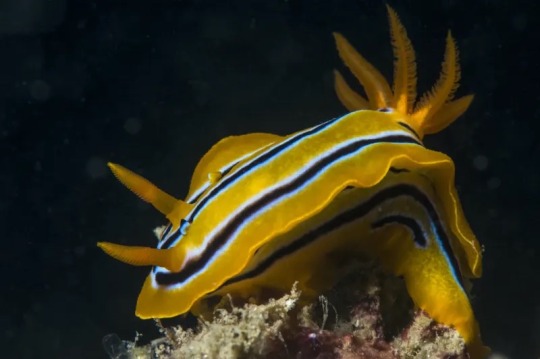






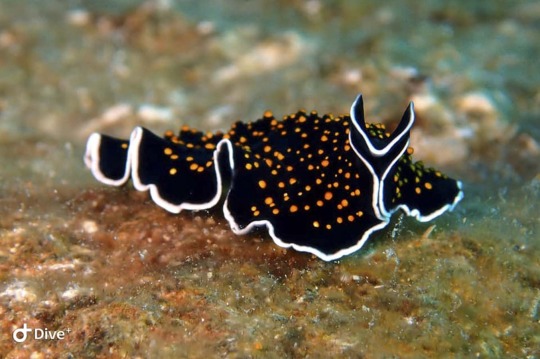

Photos do not belong to me btw I just got them off Google
Edit: I think the bottom right one might be a flatworm but they’re still awesome so I’m keeping it here as a little bonus :)
Edit 2: yeah that is a flatworm specifically a Yellow Spotted Flatworm, he’s welcome with the nudibranchs because he’s cool tho.
154 notes
·
View notes
Link
via SCUBA: explore the underwater world, online
0 notes
Link
via SCUBA: explore the underwater world, online
0 notes
Link
via SCUBA: explore the underwater world, online
0 notes